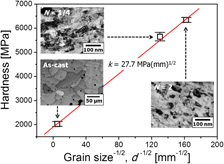Crossref Citations
This article has been cited by the following publications. This list is generated based on data provided by
Crossref.
Zhang, Nian Xian
Chinh, Nguyen Q.
Kawasaki, Megumi
Huang, Yi
and
Langdon, Terence G.
2016.
Self-annealing in a two-phase Pb-Sn alloy after processing by high-pressure torsion.
Materials Science and Engineering: A,
Vol. 666,
Issue. ,
p.
350.
Komarasamy, Mageshwari
Kumar, Nilesh
Mishra, Rajiv S.
and
Liaw, Peter K.
2016.
Anomalies in the deformation mechanism and kinetics of coarse-grained high entropy alloy.
Materials Science and Engineering: A,
Vol. 654,
Issue. ,
p.
256.
Jang, Min Ji
Joo, Soo-Hyun
Tsai, Che-Wei
Yeh, Jien-Wei
and
Kim, Hyoung Seop
2016.
Compressive deformation behavior of CrMnFeCoNi high-entropy alloy.
Metals and Materials International,
Vol. 22,
Issue. 6,
p.
982.
Tang, Qunhua
Huang, Yi
Cheng, Hu
Liao, Xiaozhou
Langdon, Terence G.
and
Dai, Pinqiang
2016.
The effect of grain size on the annealing-induced phase transformation in an Al0·3CoCrFeNi high entropy alloy.
Materials & Design,
Vol. 105,
Issue. ,
p.
381.
Lee, Dong-Hyun
Seok, Moo-Young
Zhao, Yakai
Choi, In-Chul
He, Junyang
Lu, Zhaoping
Suh, Jin-Yoo
Ramamurty, Upadrasta
Kawasaki, Megumi
Langdon, Terence G.
and
Jang, Jae-il
2016.
Spherical nanoindentation creep behavior of nanocrystalline and coarse-grained CoCrFeMnNi high-entropy alloys.
Acta Materialia,
Vol. 109,
Issue. ,
p.
314.
Zhao, Yakai
Seok, Moo-Young
Lee, Dong-Hyun
Lee, Jung-A
Suh, Jin-Yoo
and
Jang, Jae-il
2016.
Hydrogen-induced softening in nanocrystalline Ni investigated by nanoindentation.
Philosophical Magazine,
Vol. 96,
Issue. 32-34,
p.
3442.
Zheng, Ruixiao
Chen, Jing
Xiao, Wenlong
and
Ma, Chaoli
2016.
Microstructure and tensile properties of nanocrystalline (FeNiCoCu)1−xTixAlx high entropy alloys processed by high pressure torsion.
Intermetallics,
Vol. 74,
Issue. ,
p.
38.
Balasubramanian, N.
and
Langdon, Terence G.
2016.
The Strength–Grain Size Relationship in Ultrafine-Grained Metals.
Metallurgical and Materials Transactions A,
Vol. 47,
Issue. 12,
p.
5827.
Shahmir, Hamed
He, Junyang
Lu, Zhaoping
Kawasaki, Megumi
and
Langdon, Terence G.
2016.
Effect of annealing on mechanical properties of a nanocrystalline CoCrFeNiMn high-entropy alloy processed by high-pressure torsion.
Materials Science and Engineering: A,
Vol. 676,
Issue. ,
p.
294.
Kawasaki, Megumi
Ahn, Byungmin
Kumar, Praveen
Jang, Jae‐il
and
Langdon, Terence G.
2017.
Nano‐ and Micro‐Mechanical Properties of Ultrafine‐Grained Materials Processed by Severe Plastic Deformation Techniques .
Advanced Engineering Materials,
Vol. 19,
Issue. 1,
Heczel, Anita
Huang, Yi
Langdon, Terence G.
and
Gubicza, Jenő
2017.
Investigation of Lattice Defects in a Plastically Deformed High-Entropy Alloy.
Materials Science Forum,
Vol. 885,
Issue. ,
p.
74.
Zhang, Congzheng
Guan, Shaokang
Wang, Liguo
Zhu, Shijie
and
Chang, Lei
2017.
The microstructure and corrosion resistance of biological Mg–Zn–Ca alloy processed by high-pressure torsion and subsequently annealing.
Journal of Materials Research,
Vol. 32,
Issue. 6,
p.
1061.
2017.
Kawasaki, Megumi
Han, Dae-Kuen
Han, Jae-Kyung
Jang, Jae-il
and
Langdon, Terence G
2017.
Fabrication of hybrid metal systems through the application of high-pressure torsion.
IOP Conference Series: Materials Science and Engineering,
Vol. 194,
Issue. ,
p.
012002.
Jang, Min Ji
Ahn, Dong-Hyun
Moon, Jongun
Bae, Jae Wung
Yim, Dami
Yeh, Jien-Wei
Estrin, Yuri
and
Kim, Hyoung Seop
2017.
Constitutive modeling of deformation behavior of high-entropy alloys with face-centered cubic crystal structure.
Materials Research Letters,
Vol. 5,
Issue. 5,
p.
350.
Koch, Carl C.
2017.
Nanocrystalline high-entropy alloys.
Journal of Materials Research,
Vol. 32,
Issue. 18,
p.
3435.
Lee, Dong-Hyun
Lee, Jung-A
Zhao, Yakai
Lu, Zhaoping
Suh, Jin-Yoo
Kim, Ju-Young
Ramamurty, Upadrasta
Kawasaki, Megumi
Langdon, Terence G.
and
Jang, Jae-il
2017.
Annealing effect on plastic flow in nanocrystalline CoCrFeMnNi high-entropy alloy: A nanomechanical analysis.
Acta Materialia,
Vol. 140,
Issue. ,
p.
443.
Kawasaki, Megumi
and
Langdon, Terence G.
2017.
Using Severe Plastic Deformation to Fabricate Strong Metal Matrix Composites.
Materials Research,
Vol. 20,
Issue. suppl 1,
p.
46.
Shahmir, Hamed
He, Junyang
Lu, Zhaoping
Kawasaki, Megumi
and
Langdon, Terence G.
2017.
Evidence for superplasticity in a CoCrFeNiMn high-entropy alloy processed by high-pressure torsion.
Materials Science and Engineering: A,
Vol. 685,
Issue. ,
p.
342.
Maier-Kiener, Verena
Schuh, Benjamin
George, Easo P.
Clemens, Helmut
and
Hohenwarter, Anton
2017.
Insights into the deformation behavior of the CrMnFeCoNi high-entropy alloy revealed by elevated temperature nanoindentation.
Journal of Materials Research,
Vol. 32,
Issue. 14,
p.
2658.



